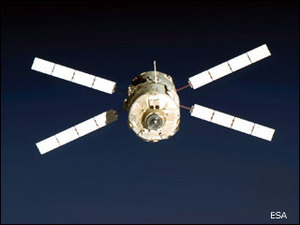
|
| ©ESA |
Better to burn out than fade away? For a celestial chunk of important space junk, the next few weeks will offer several faint glimpses of what will soon be a fireball.
An unmanned spacecraft that ferried cargo to the International Space Station will make a few more visible passes overhead before crash landing into the Earth's atmosphere on or around Sept. 29.
The Jules Verne Automated Transfer Vehicle launched March 9, 2008, and arrived at the International Space Station on April 3, where it remained docked while tons of cargo were off-loaded -- and tons of waste materials from the space station were loaded back onto the ATV.
Since undocking from the station Sept. 5, Jules Verne is preparing for its final voyage: a crash landing in Earth's atmosphere. The event will create a fireball in the sky as the vehicle breaks up over the South Pacific Ocean. NASA plans to monitor the crash from the air.
A new ATV will launch and dock with the station approximately every 17 months, according to the European Space Agency.
You can catch a glimpse of the Jules Verne passing through the heavens above before it burns out becomes history.
The crash landing itself will be visible from the South Pacific. For upcoming opportunities to spot the Jules Verne ATV in the U.S. and Canada, click here and enter your postal ZIP code.



Reader Comments
to our Newsletter